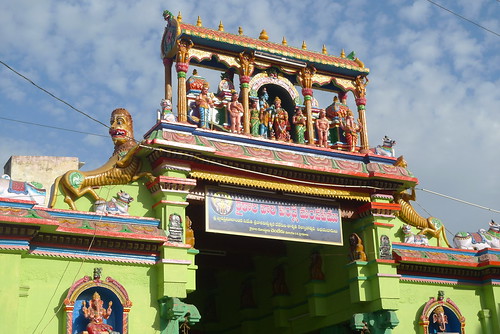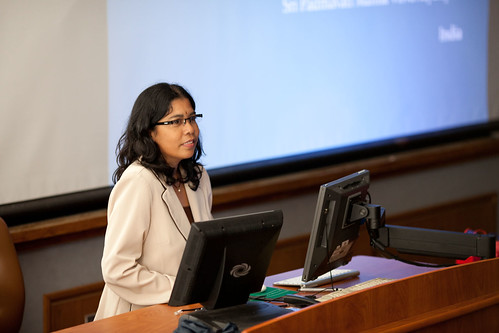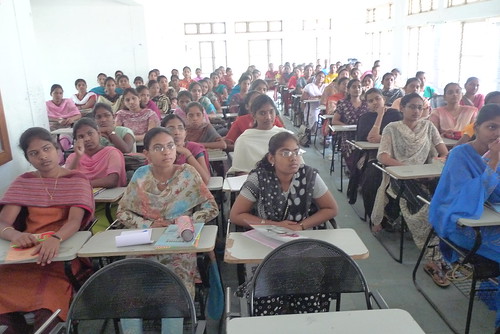Saturday, March 30, 2013
New Media International Conference in India
By Morgan Sigrist
IIJ Assistant & Ambassador
The Institute for
International Journalism in the E. W. Scripps School of Journalism, Scripps
College of Communication, and Sri Padmavati Mahila Visvavidyalayam Tirupati, in
India, are organizing an International
academic conference in India. The conference is scheduled to be held from
November 20-22, 2013 in Tirupati, a popular tourist destination. The conference
is titled “Changing Landscape in Communication with New Media Technologies:
Issues and Challenges”, and will focus on themes of social engagement,
education and public health, and political discourse.
The key objective of the conference is to understand how new
media
And mobile technology can be used to enhance our
understanding of the issues of interest and to provide effective and innovative
solutions. Participants from different parts of the world will help
stimulate discussion about these issues and will provide a platform where the
significance of media technology can be discussed from different perspectives.
The organizing coordinator in India is Professor Dr. Vijaya
Lakshmi, who also is a SUSI 2012 alumnus. The Study of the U.S. Institute
(SUSI) on Journalism and Media is an annual summer institute of international
journalism scholars and media experts from universities and academic
institutions from around the world. The SUSI summer institute is funded by an
annual renewable grant from the U.S. Department of State's Study
of the U.S. Branch in the Office of Academic Exchange Programs.
“ Different countries at different stages of development may
have different range of salient issues. For example, for developed countries, social
engagement and political discourse may be more important issues, whereas for
developing countries, fundamental issues like education and public health may
have more importance. Bringing together scholars from
different countries and sociopolitical environments may create great
opportunities for mutual learning,” said Dr. Jatin Srivastava, one of the
conference directors.
Dr. Srivastava observed that new media technology is
increasingly becoming a dominant tool to address various social, political, and
economic issues; this will provide a common frame of reference to participants
to think about these problems and evaluate media and technology-based
solutions.
The conference is inviting abstracts and articles from
academicians and practitioners from countries all over the world; these
submissions may cover qualitative or quantitative research and may also be
about media based initiatives like campaign and new media products.
Friday, March 8, 2013
Admiring She-Roes
Ms. Aazadi Fateh Muhammad
SUSI 2012 - Pakistan
“For living a Life, I really fight Hard”… an
ordinary woman’s expression stated decades ago in the Poetry of Shah Abdul
Latif Bhitai, an accurate description that how far great efforts are placed by
the modern women to achieve their rights, as well. Women, like men are equally
human, living and full of life, but unfortunately, they have to struggle doubly
hard to prove their identity and status in society. They are continuously
discouraged by an assortment of general biases, underestimated as weak and meek
creatures. This is not only predicament of developing societies, but these discriminatory
mind sets and behaviors can be easily seen in so called ultra modern world as
well, where even a woman has no specific title for her other than ‘Women’,
which means Wife of Men. Means treating them as a property of men is
not a fashion of eastern societies just.
 |
| A Village Woman in Sindh Province |
Gender based biases and violence, like
charity, begins at home. Our family structures and socialization patterns
generally support male members. Since childhood family members are directed to
behave and live on gender lines. Not only in Islam but the constitution and
laws of Pakistan award women their all basic rights and status in society.
Faces of Pakistani woman represent millions
of identities, tales and fragments of society at the same time. Pakistani
women, no matter living in urban or rural setups, are fighting at many stages
to prove their own individuality and status. However, lack of education, poor awareness,
social ignorance and male dominating social patterns are main hindrances in the
way of her courage and success.
Aurat
Foundation (A local NGO) reports that violence against women decreased by
6.41 percent in 2010 compared to figure from 2009, the report revealed that
8,000 cases were reported across the country in 2010 against 8,548 cases in
2009. Still serious measures are required to introduce new concrete laws and
their implementation. According to Aurat Foundation report 7,733 cases of
violence against women including hurt, torture, burning, rape, domestic
violence, threat to violence and more were reported in the media but very few
of them were answered positively. Most part of this crime has not been named by
the law nor recognized by the state so it goes unpunished. In this scenario
Harassment at work places bill and property rights of women law are music for
the ears.
Population Reference Bureau Washington issued
a data sheet in 2011 which shows 59% female (Age 15 to 24) literacy rate in
Pakistan and in total female population of 91.6 millions only 22% of them are
active in economy. Means more than half percent of women population are not
being utilized and ultimately have less opportunities and exposure to work.
We are celebrating Pakistani Women Day on March 8 across the country with the International World, for acknowledging women achievements and raising
awareness to protect their rights. This day is celebrated in the memory of
those women who raised their voice against discriminatory and draconian laws of
a dictator in early 80s. What is hidden and can be seen in a face of Pakistani
woman? Let’s see below how intellectuals’ educationists and public
representatives act in response towards this question.
A Pakistani woman has her own rightful
identity. Pakistani women are beautiful, intelligent and hold capability of
doing anything against all odds. Pakistani society in general and specially the
religious groups are reluctant to give them their rightful place. Most of them
think that they should be confined to their homes; are meant only for producing
male children and taking care of family is what primary aim of their lives,
said Bari Awan, an active member of War against Rape since 90s.
| Asma Jilani Jahangir is a leading Pakistani lawyer, advocate of the Supreme Court of Pakistan, President Supreme Court Bar Association of Pakistan and human rights activist, who works both in Pakistan and internationally to prevent the persecution of religious minorities, women, and exploitation of children. |
Prof. Shahida Kazi (Head, department of Media Sciences at Institute
of Business Management, Karachi) expressed her views as saying that
Pakistani woman has so many different faces. “I will say that for the most
part, because of centuries of suppression the Pakistani woman is one who has
learnt to be cunning, scheming and manipulative in order to survive. Of course,
there are exceptions but for the most part we are not straightforward or open
even when there is no need to be crafty. And this goes for all, educated,
uneducated, high class, low class, young, and old. Status of women in Pakistan
differs according to circumstances. However I think all women of every class
are basically nothing but commodities, generally taken as the property of their
men”.
In the opinion of Dr. Zareen Abbasi
(Professor at a Local University), she believes that Pakistani women are courageous,
loyal, hardworking, sincere and leading at every walk of life in society
excluding all that she is capable for, her status is still not recognized at home nor even at working places.
excluding all that she is capable for, her status is still not recognized at home nor even at working places.
Rasool Bux Sarang working as Assistant Manager Media, at Aga Khan University
elaborated his point of view as, being a professional career woman, worker or a
house wife, a Pakistani woman is an example of a dedicated family member whose joys,
sorrows, successes or failures are usually linked to her family, but who
understands the larger role she can play in improving society. Majority of
Pakistani women are dependent and powerless - still struggling for their
individual identities. Modern communication sources are playing a good role in
creating the awareness that a woman with a more productive role in society can
benefit not only to her family but also the larger society.
A young graduate Khushboo Rafique, responded to the question picked a rural woman as a model while defining a Pakistani woman; she has the real face of Pakistan. In my opinion, a Pakistani woman is a devoting and hard working woman who dedicates her own life to her family.
Pakistani society is basically a
male-dominating society where status of a woman is not satisfactory. Obsolete
customs and traditions, lack of religious knowledge and education are the main
causes. Men are given more favor and attention in most of the families against
their female counterparts. The real gender discrimination thus starts from
homes. Women are considered not more than property in rural areas particularly the
condition in urban areas is far better but women in urban areas also suffer a
lot of problems in different paths of life.
 |
| Kiran Baloch is the record holder of the highest individual score in the international game. She scored 242 in the first cricket Test against the West Indies |
In
patriarchal societies like Pakistan, women are habituated to consent to men as
the superior human being. However awareness, education and struggle for life
may change the picture in general. History is full of enlightening examples of
Great women leaders, artists, scientists, and other professional women from all
walks of life, which have inspired other women to overcome social obstacles.
Need of the time is to focus on specific
change leading communication campaigns who can actually bring up some
differences in the existing mind sets and social patterns. Covering more than
half of the country population, they deserve to be nourished and appreciated by
the society without any discrimination.
As Maya Angelou (an African American Poetess) said: It is equally important to recognize and celebrate our she-roes just
like the he-roes. Let’s celebrate power and beauty of feminity not only on March 8, but onwards.
Subscribe to:
Posts (Atom)





